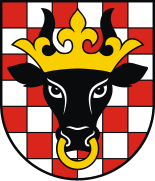
Head
A head is the part of an organism which usually includes the ears, brain, forehead, cheeks, chin, eyes, nose, and mouth, each of which aid in various sensory functions such as sight, hearing, smell, and taste. Some very simple animals may not have a head, but many bilaterally symmetric forms do, regardless of size.
This article is about heads in general. For the heads of humans, see Human head. For other uses, see Head (disambiguation).Head
Heads develop in animals by an evolutionary trend known as cephalization. In bilaterally symmetrical animals, nervous tissue concentrate at the anterior region, forming structures responsible for information processing. Through biological evolution, sense organs and feeding structures also concentrate into the anterior region; these collectively form the head.
The human head is an anatomical unit that consists of the skull, hyoid bone and cervical vertebrae. The term "skull" collectively denotes the mandible (lower jaw bone) and the cranium (upper portion of the skull that houses the brain).
Sculptures of human heads are generally based on a skeletal structure that consists of a cranium, jawbone, and cheekbone. Though the number of muscles making up the face is generally consistent between sculptures, the shape of the muscles varies widely based on the function, development, and expressions reflected on the faces of the subjects.[3]
Proponents of identism believe that the mind is identical to the brain. Philosopher John Searle asserts his identist beliefs, stating "the brain is the only thing in the human head". Similarly, Dr. Henry Bennet-Clark has stated that the head encloses billions of "miniagents and microagents (with no single Boss)".[4]






